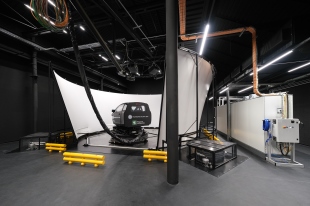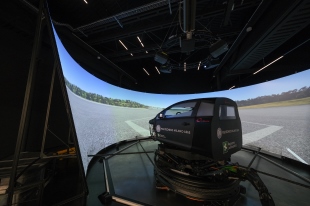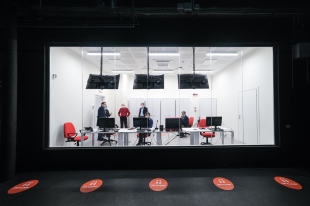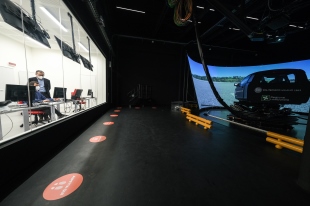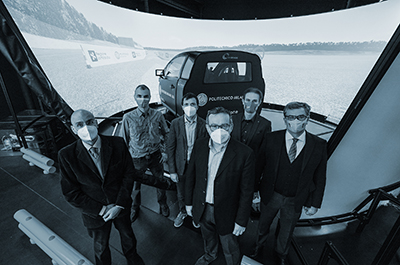
Politecnico di Milano has just presented the first installation of DiM400 in the world. Co-sponsored by Regione Lombardia and designed and engineered by VI-grade, DiM400 is the most innovative driving simulator existing on the market today. Acquiring the simulator represents a milestone for automotive scientific research, considering that, from now on, the University owns a unique tool to develop sustainable mobility.
The driving simulator will be used: to design and build new eco-friendly vehicles, to develop components using innovative materials, for applications about vehicle dynamics, to optimise consumptions, to verify that the Advanced Driver-Assistance Systems (ADAS) work properly, for applications connecting vehicles and infrastructures, and for applications of autonomous driving. Moreover, it will make sustainable motorsport possible.
This 5-million euro system, in which Regione Lombardia invested 2 million euros, has been installed in our Bovisa campus and is the main asset of a project enhanced by Cluster Lombardo della Mobilità. The objective of this project is to create a centre - the fourth in Europe - accessible to all automotive companies part of the Lombardy region cluster.
Here follow the words of the rector Ferruccio Resta and our DMEC colleagues Prof. Gianpiero Mastinu and Prof. Federico Cheli, which made an enormous effort to reach such incredible goal.
Prof. Ferruccio Resta said: “Experimental infrastructures and cutting-edge laboratories are key elements of international research and business development. Installing the driving simulator will allow Politecnico di Milano to have an open discussion with some of the most important international players, meanwhile turning Bovisa into a European innovation ecosystem. That is how the University aims to tackle the challenges of the future, mobility first of all”.
Prof. Giampiero Mastinu explained: “The idea of promoting a driving simulator at PoliMi occurred by chance. The president of the Cluster Lombardo della Mobilità (CLM) called me one day and kindly persuaded me to participate in a very important dinner in Brescia. I was talking with an academic colleague discussing how to promote R&D activities in automotive companies. The driving simulator sounded like a great idea. On the occasion of the next CLM assembly (November 2017), I presented the project INRIMOS. Many important Lombardy companies immediately endorsed the initiative. Sooner than later, I realised VI-grade could be an excellent supplier, even though the product was merely a project still far from its accomplishment. In agreement with our rector, we decided to bet on the installation of a unique and original simulator. Surely the PoliMi simulator would also be a resource for research activities in many different fields, but mostly addresses the research themes of the Machine and Vehicle Design Research Line: Vehicle construction, AI optimisation, Lightweight Construction, Reliability, and so much more. Later followed a series of promotional events for the INRIMOS project, sponsored by CLM and PoliMi. We had to convince administrative officers and regional politicians that this was indeed a good idea. Surprisingly, it turned out that Regione Lombardia, namely the Department of Education, University, Research, Innovation, and Simplification, was particularly caring about automotive research themes, which are remarkable for both us and the economy of Lombardy. To pursue such a complicated task, it was necessary to share resources, especially funds. I also discussed with my colleagues Prof. Gobbi and Prof. Cheli, and everyone agreed on bringing forward the proposal. Without their support, none of this today would have been possible”.
Prof. Federico Cheli added: "Our passion for vehicles and driving are the foundations on which relies the research activities carried out by a group of (young and less younger) fellows of the Dynamics and Vibrations Research Line. Over the years, we gained experience in modelling vehicles and their components, experimenting, and, more recently, developing active control systems and autonomous driving. Our research aims at improving the performance, safety, reliability, and efficiency of the vehicles we use daily. However, even though in the past few years we developed more precise and reliable models, there is still an element that remains uncertain and “tricky”. The person behind the wheel is the most difficult to describe through math models but definitely the most important. Optimising the vehicle responsiveness, particularly when it comes to self-driving vehicles, can not ignore the driver’s reactions. Being accepted by their users requires specific research that must include the human factor. DriSMi is the state of the art of dynamic driving simulators: it offers a high-realistic and immersive simulation environment where the person directly experiences the vehicle's response to its commands. It is what was missing and will allow in the following years to design vehicles with their electrification, connectivity, and autonomous driving customized on their users".
The DriSMi could also be useful to boost innovative teaching for our Mechanical Engineering Undergraduate and Postgraduate Programmes. The Formula SAE and Shell-Eco Marathon teams can profit from a system that is not available in many other Universities.
Throughout a series of webinars (live or recorded), the DriSMi is already included in the activities that led the Department of Mechanical Engineering to be nominated as Department of Excellence on a national level.
- 18-2-2021 h 18:00, I4.0 & Automotive Design Process: the digitalisation of design processes – boosted by DriSMi – does and will invest in researches on vehicle dynamics, accurate measures to power vehicle digital twins, components design, and construction with new materials.
- 19-2-2021 h 18:00, ITS & I4.0 /Traffic: Intelligent Transport Systems are and will be studied, in particular autonomous vehicles and the situation (traffic) in which they drive, and the vehicle components with ITS features developed through I4.0 paradigms.
- 25-2-2021 h 18:00, Green Vehicles and Lightweight Construction: tests carried out on DriSMi will allow verifying research on eco-friendly vehicles and light-weighting vehicles.
- 26-2-2021 h 18:00, ITS & I4.0 /HMI, new components for autonomous driving, are and will be developed with I4.0 paradigms, in particular the ones involving vehicle-driver interactions.
Finally, the DriSMi is already active on the European AI@EDGE Project focused on driving simulations with autonomous vehicles on railways.

